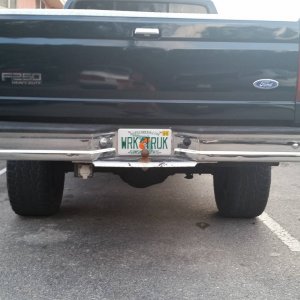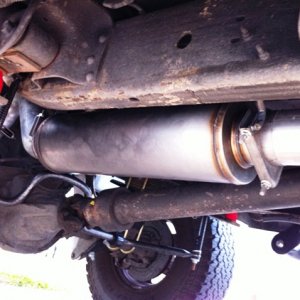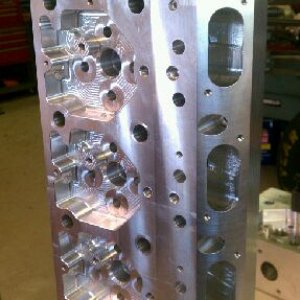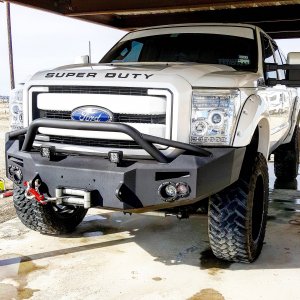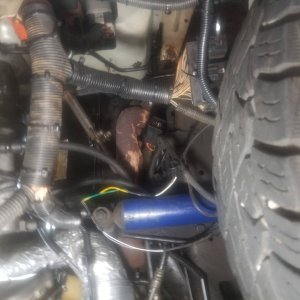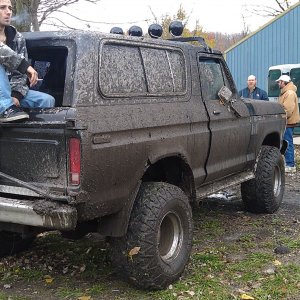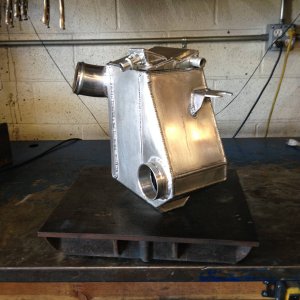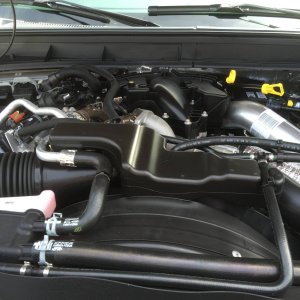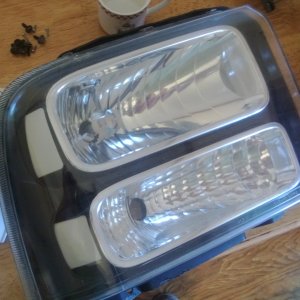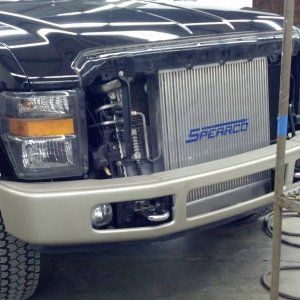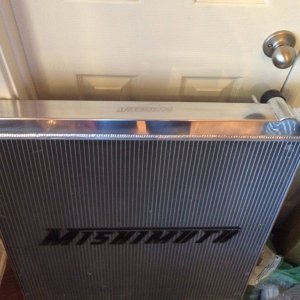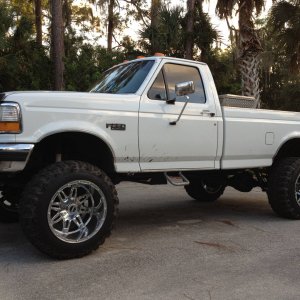You are using an out of date browser. It may not display this or other websites correctly.
You should upgrade or use an alternative browser.
You should upgrade or use an alternative browser.
Stage 2 vs 2.5 vs 3 VGT Turbos (Barder or KC)
- Thread starter BlueFordExcursion
- Start date
FaSSt9602
New member
While I imagine it might help some, it is not really as necessary with a VGT since tuning can adjust vane position for better spool up.
strokin6L
Active member
Yeah...I think something like a stock stall(1800) is good for a vgt....even a stage 3(68mm). I did a converter stall test today and mine stalled at about 1400....a bit lower than 1800. I need a converter bad. My truck just doesn't accelerate and have the mid range-top end pull like it use to. Its kind of a dog.
Last edited:
Strokin89
Member
Has anyone ever run a stage 3 in a truck with a zf6?
2005 F250 6.0 powerstroke, 6 speed manual, egr delete, arp head studs, new oil cooler, aftermarket coolant filter, custom intake, 4" down pipe into dual 6" stacks, 8" lift, TSD super panty dropper tune.
2005 F250 6.0 powerstroke, 6 speed manual, egr delete, arp head studs, new oil cooler, aftermarket coolant filter, custom intake, 4" down pipe into dual 6" stacks, 8" lift, TSD super panty dropper tune.
I tell most people that on a race tune you want to hit about 1500 degrees egts. If you are not hitting 1500 degrees egts then you are not driving the turbo hard enough to make peak power. Anything over 1500 degrees means you need a bigger turbo and anything under 1500 means you need more fuel. You can easily maintain 1500 egts for 15-20 seconds without any problems. But you would not want to hold 1500 egts for a couple of minutes because you could start to melt your motor. But you are not so interested in making race power... you want tow power.
Most guys who tow heavy and tow healthy try to keep egts under 1250 degrees (thats when our pistons start to melt). You can tow all day every day at 1200 egts and the motor will not melt or have any issues. You can even sustain 1300 for a couple of minutes but you would not want to keep at those temps all day because it will eventually melt your motor. The pistons will not just magically melt once you hit 1250egts just like how snow does not melt in the shade when temps are above freezing... it takes time. You would expect and want to keep the rpms above 2000rpms and maintain around 800-1300 egts while pulling a big heavy load on a tow tune.
So why a bigger turbo than stock??? What about my cruising egts???
Well a bigger turbo will sacrifice a little bit of power down low but you will gain extra flow up top. You are essentially moving the powerband on the truck. This will help to keep your higher egts down but it will raise up your lower egts a little bit...
Here is an example of what I would expect with your truck with 175cc injectors comparing stock turbo vs stage 2 vs stage 3 turbo... I will highlight different colors to show how each turbo shines in a different area...
Green = great
Orange = good
Purple = undesirable
Stock turbo -
Cruising egts empty - 650-750
Crusing egts towing - 800-950
WOT egts tow tune towing heavy up hill - 1400 egts
WOT egts max fuel race tune - 1700 egts
Stage 2 turbo -
Cruising egts empty - 700-800
Crusing egts towing - 850-1000
WOT egts tow tune towing heavy up hill - 1300 egts
WOT egts max fuel race tune - 1550 egts
Stage 3 turbo -
Cruising egts empty - 750-850
Crusing egts towing - 950-1100
WOT egts tow tune towing heavy up hill - 1200 egts
WOT egts max fuel race tune - 1450 egts
With all that said you can see that the smaller turbos do better under light load and a bigger turbo does better under heavy load. You are moving the power curve in the rpm band. Different sized turbos will operate more efficiently at different areas of the compressor map/rpm band.
Everything is a trade off in the turbo world. Bigger turbos will move the power band to the right on a dyno graph and up in the higher rpms. That is just how turbo theory works. The opposite is also true, smaller turbos will move the power to the left and lower in the rpms. This starts to become noticeable with cruising egts and with turbo lag. The most noticeable area that shows these difference is in OD with the tq converter locked... which is where we cruise.
It is not possible to get a big turbo to spool as fast as a smaller turbo for many reasons. One being that it is just harder to get a bigger turbo to spool that fast because of the larger parts (but vgt vanes can change that a little). The other thing to note is that if a big turbo spools up too fast then it will surge. There are many things that can help in tuning. Especially off the line, but when locked int OD it becomes more obvious.
I made up a little drawing comparing a recent dyno graph where someone dyno'd their truck with stock turbo and stock injectors... then jumped up to a larger turbo with larger injectors. I had to use paint to overlay the two separate graphs. I also erased the hp curve because you don't really need both curves.
This will show the affects and difference in power between a small stock turbo and a larger vgt turbo. I do not have an actual compressor map for the stage 3 turbo that was run... but the powermax vs stock turbo compressor map will show the same principles. I made little dots to try and color coordinate the graph without completely filling it in. It would take weeks to run all the actually plots on the compressor map... so I just guestimated to show the general turbo theory.
Also I hope you keep this in the back of your mind... simply stating peak hp/tq numbers off of a dyno is basically useless IMO. That is one teeny tiny point on the graph and you will learn very little about what the truck actually does. But if you study the whole graph then Dynos are WAY more educational than just comparing peak numbers or even just testing things at the track.
The solid blue line is the smaller turbo
The thin red line is the bigger stage 3 turbo
Think of the Y-axis as power/boost and the X-axis as rpm/flow. They are basically the same thing when talking about turbos.
Also remember these are not the two turbos that we have in question... but it will give the same idea/theory

The green area represents where most of us cruise. That is at lower boost (3-9psi) and lower rpms (1500-1900). You can see on the dyno chart shown on the left that the smaller turbo makes considerable more power at that area. That is because it runs more efficient and it is able to produce boost sooner. Even if the two turbos were able to achieve the same boost level at these low rpms... the smaller turbo would be running more efficiently/cooler because it does not have to work as hard to do the same amount of work and it falls in a more efficient area of the map. Now if you look at where the green dots correlate on a compressor map you will see that they are in a very efficient area of the stock turbo map... but they are "under the turbo" on the powermax compressor map. That is what is considered "getting under the turbo". That can cause high egts and turbo lag.
The orange area of the dyno chart shows how much sooner and how much more power you can make with a smaller turbo in the lower rpms range (like when cruising and towing and low rpms). If a race was to end at 2500 rpms the smaller turbo would win. It spools faster and more efficiently at a lower rpm so the power kicks in much sooner. You can see that on the compressor map with the little orange dots. You can see how these orange dots fall on the stock compressor map but they are to the left of the powermax compressor map. That is because it is not physically possible for the powermax to spool up that fast. Even if you were to use tuning/vgt vanes/overfueling to get the turbo so spool that fast... it would just surge.
Looking at the dyno chart the purple dots represent where the stock turbo starts to die out and the bigger turbo takes over. You can see that at 2500 rpms the bigger turbo starts to make WAY MORE POWER and it just keep climbing. The bigger turbo will move the power up and to the right in the rpm band. All those little dots show where the bigger turbo makes more power than the little turbo. It will be no contest in these areas which turbo makes more power, has lower egts, builds more boost, and flows more air. Now if you look over on the compressor map you will see that the purple dots fall to the right of the stock turbo, but it still falls on the powermax compressor map. That means that the larger turbo is able to flow more air on the top end. If the small turbo was to reach that side of the compressor map then it would "choke out" and possibly overspeed. This will also explain why the bigger turbos (like the 2003,powermax, stage 2, stage 3). They really like to scream at the top of the rpms band, whether it be racing or towing.
The black dots represent where both turbos, on average, will run just about the same. This would represent light throttle in the middle of the rpm band driving. You can see that this area falls underneath both power curves on the dyno chart and fall right in the middle of both compressor maps.
Now there are also turbine maps that would help to explain everything better but Garrett does not provide those for our VGT turbos. But bascially... similar to the compressor maps... you would see that the smaller turbine wheel spools up quicker, but will choke out faster. The bigger turbine wheel will take longer to spool up but it can exceed the flow rate of the smaller turbine wheel. You might have noticed that the 2003 and 2004 turbine wheels share the same 72.5x66 measurements... BUT they are very different wheels. Size is not everything. Number of blades, blade profile, inducer height, vanes, etc will all affect how the turbine spools up and flows air.
Turbo sizing has a lot to do with WHERE you want the power. Down low, up top, mid range, tons of HP, tons of Torque, quicker spooling, higher flowing etc... etc... You can't have it all. If you could then there would only be one turbo size.
Most guys who tow heavy and tow healthy try to keep egts under 1250 degrees (thats when our pistons start to melt). You can tow all day every day at 1200 egts and the motor will not melt or have any issues. You can even sustain 1300 for a couple of minutes but you would not want to keep at those temps all day because it will eventually melt your motor. The pistons will not just magically melt once you hit 1250egts just like how snow does not melt in the shade when temps are above freezing... it takes time. You would expect and want to keep the rpms above 2000rpms and maintain around 800-1300 egts while pulling a big heavy load on a tow tune.
So why a bigger turbo than stock??? What about my cruising egts???
Well a bigger turbo will sacrifice a little bit of power down low but you will gain extra flow up top. You are essentially moving the powerband on the truck. This will help to keep your higher egts down but it will raise up your lower egts a little bit...
Here is an example of what I would expect with your truck with 175cc injectors comparing stock turbo vs stage 2 vs stage 3 turbo... I will highlight different colors to show how each turbo shines in a different area...
Green = great
Orange = good
Purple = undesirable
Stock turbo -
Cruising egts empty - 650-750
Crusing egts towing - 800-950
WOT egts tow tune towing heavy up hill - 1400 egts
WOT egts max fuel race tune - 1700 egts
Stage 2 turbo -
Cruising egts empty - 700-800
Crusing egts towing - 850-1000
WOT egts tow tune towing heavy up hill - 1300 egts
WOT egts max fuel race tune - 1550 egts
Stage 3 turbo -
Cruising egts empty - 750-850
Crusing egts towing - 950-1100
WOT egts tow tune towing heavy up hill - 1200 egts
WOT egts max fuel race tune - 1450 egts
With all that said you can see that the smaller turbos do better under light load and a bigger turbo does better under heavy load. You are moving the power curve in the rpm band. Different sized turbos will operate more efficiently at different areas of the compressor map/rpm band.
Everything is a trade off in the turbo world. Bigger turbos will move the power band to the right on a dyno graph and up in the higher rpms. That is just how turbo theory works. The opposite is also true, smaller turbos will move the power to the left and lower in the rpms. This starts to become noticeable with cruising egts and with turbo lag. The most noticeable area that shows these difference is in OD with the tq converter locked... which is where we cruise.
It is not possible to get a big turbo to spool as fast as a smaller turbo for many reasons. One being that it is just harder to get a bigger turbo to spool that fast because of the larger parts (but vgt vanes can change that a little). The other thing to note is that if a big turbo spools up too fast then it will surge. There are many things that can help in tuning. Especially off the line, but when locked int OD it becomes more obvious.
I made up a little drawing comparing a recent dyno graph where someone dyno'd their truck with stock turbo and stock injectors... then jumped up to a larger turbo with larger injectors. I had to use paint to overlay the two separate graphs. I also erased the hp curve because you don't really need both curves.
This will show the affects and difference in power between a small stock turbo and a larger vgt turbo. I do not have an actual compressor map for the stage 3 turbo that was run... but the powermax vs stock turbo compressor map will show the same principles. I made little dots to try and color coordinate the graph without completely filling it in. It would take weeks to run all the actually plots on the compressor map... so I just guestimated to show the general turbo theory.
Also I hope you keep this in the back of your mind... simply stating peak hp/tq numbers off of a dyno is basically useless IMO. That is one teeny tiny point on the graph and you will learn very little about what the truck actually does. But if you study the whole graph then Dynos are WAY more educational than just comparing peak numbers or even just testing things at the track.
The solid blue line is the smaller turbo
The thin red line is the bigger stage 3 turbo
Think of the Y-axis as power/boost and the X-axis as rpm/flow. They are basically the same thing when talking about turbos.
Also remember these are not the two turbos that we have in question... but it will give the same idea/theory
The green area represents where most of us cruise. That is at lower boost (3-9psi) and lower rpms (1500-1900). You can see on the dyno chart shown on the left that the smaller turbo makes considerable more power at that area. That is because it runs more efficient and it is able to produce boost sooner. Even if the two turbos were able to achieve the same boost level at these low rpms... the smaller turbo would be running more efficiently/cooler because it does not have to work as hard to do the same amount of work and it falls in a more efficient area of the map. Now if you look at where the green dots correlate on a compressor map you will see that they are in a very efficient area of the stock turbo map... but they are "under the turbo" on the powermax compressor map. That is what is considered "getting under the turbo". That can cause high egts and turbo lag.
The orange area of the dyno chart shows how much sooner and how much more power you can make with a smaller turbo in the lower rpms range (like when cruising and towing and low rpms). If a race was to end at 2500 rpms the smaller turbo would win. It spools faster and more efficiently at a lower rpm so the power kicks in much sooner. You can see that on the compressor map with the little orange dots. You can see how these orange dots fall on the stock compressor map but they are to the left of the powermax compressor map. That is because it is not physically possible for the powermax to spool up that fast. Even if you were to use tuning/vgt vanes/overfueling to get the turbo so spool that fast... it would just surge.
Looking at the dyno chart the purple dots represent where the stock turbo starts to die out and the bigger turbo takes over. You can see that at 2500 rpms the bigger turbo starts to make WAY MORE POWER and it just keep climbing. The bigger turbo will move the power up and to the right in the rpm band. All those little dots show where the bigger turbo makes more power than the little turbo. It will be no contest in these areas which turbo makes more power, has lower egts, builds more boost, and flows more air. Now if you look over on the compressor map you will see that the purple dots fall to the right of the stock turbo, but it still falls on the powermax compressor map. That means that the larger turbo is able to flow more air on the top end. If the small turbo was to reach that side of the compressor map then it would "choke out" and possibly overspeed. This will also explain why the bigger turbos (like the 2003,powermax, stage 2, stage 3). They really like to scream at the top of the rpms band, whether it be racing or towing.
The black dots represent where both turbos, on average, will run just about the same. This would represent light throttle in the middle of the rpm band driving. You can see that this area falls underneath both power curves on the dyno chart and fall right in the middle of both compressor maps.
Now there are also turbine maps that would help to explain everything better but Garrett does not provide those for our VGT turbos. But bascially... similar to the compressor maps... you would see that the smaller turbine wheel spools up quicker, but will choke out faster. The bigger turbine wheel will take longer to spool up but it can exceed the flow rate of the smaller turbine wheel. You might have noticed that the 2003 and 2004 turbine wheels share the same 72.5x66 measurements... BUT they are very different wheels. Size is not everything. Number of blades, blade profile, inducer height, vanes, etc will all affect how the turbine spools up and flows air.
Turbo sizing has a lot to do with WHERE you want the power. Down low, up top, mid range, tons of HP, tons of Torque, quicker spooling, higher flowing etc... etc... You can't have it all. If you could then there would only be one turbo size.
swinky
New member
Higher stall will help no matter what. The engine moves more air at higher rpms and will help decrease lag. More noticeable on a non vgt but it still helps the big vgts. 2100 stall precision is a great choice for a 68mm vgt imo. You agree charlie?
Higher stall will help no matter what. The engine moves more air at higher rpms and will help decrease lag. More noticeable on a non vgt but it still helps the big vgts. 2100 stall precision is a great choice for a 68mm vgt imo. You agree charlie?
I have often thought about trying out a higher stall to see what happens. I don't know anyone running a higher stall with a big vgt... but I do know a few guys that had bad transmissions that were shifting/stalling weird and made the turbo spool like crap. Once they got a new tranny it was like a whole new truck.
Logically I could argue both ways about how much it could help. But this is how i see it. A higher stall converter helps you to get higher up the in rpms sooner so that the turbo can operate more efficiently sooner. Big turbos don't like low rpms. You can look at the dyno and compressor maps that I put up and see that the big turbos make less power down low... so the sooner you can get them into their peak operating range, the quicker they will spool, run more efficiently, and the better your truck will run.
A higher stall converter would definitely help guys off the line. It will help the turbo to hit that sweet spot much sooner. But most big VGTs don't usually have off the line issues with power. Most guys have a hard time keeping the tires from spinning if you roll into the throttle and floor it. Where big vgts struggle is when guys are cruising around at 1700-2000 rpms. You can see from the dyno graph that under 2500rpms the smaller turbo is actually running more efficiently and making more power. The opposite is also true, the bigger turbo will be running less efficiently and making less power (even at light throttle). The vanes can help get the turbo spool up sooner... but it still won't operate as efficient as as smaller turbo under 2500rpms... no matter what you do. Those same vanes that help the turbo spool sooner become a slight restriction and can cause a loss in efficiency which usually leads to slightly higher egts (as opposed to a non-vgt which is more free flowing).
livinlots26
New member
- Joined
- Jan 23, 2013
- Messages
- 79
- Reaction score
- 0
Has anyone ever run a stage 3 in a truck with a zf6?
2005 F250 6.0 powerstroke, 6 speed manual, egr delete, arp head studs, new oil cooler, aftermarket coolant filter, custom intake, 4" down pipe into dual 6" stacks, 8" lift, TSD super panty dropper tune.
I have been wondering this very same question for awhile
Strokin89
Member
I have been wondering this very same question for awhile
I've noticed on a couple threads people have been saying that. Never knew there were this many members on here with a stick. I'm stuck between a barder and a non vgt.
2005 F250 6.0 powerstroke, 6 speed manual, egr delete, arp head studs, new oil cooler, aftermarket coolant filter, custom intake, 4" down pipe into dual 6" stacks, 8" lift, TSD super panty dropper tune.
william_ace
New member
- Joined
- Sep 25, 2013
- Messages
- 279
- Reaction score
- 0
I've got a Barder stage 3 paired with a zf6.
Strokin89
Member
How do u like it?
2005 F250 6.0 powerstroke, 6 speed manual, egr delete, arp head studs, new oil cooler, aftermarket coolant filter, custom intake, 4" down pipe into dual 6" stacks, 8" lift, TSD super panty dropper tune.
2005 F250 6.0 powerstroke, 6 speed manual, egr delete, arp head studs, new oil cooler, aftermarket coolant filter, custom intake, 4" down pipe into dual 6" stacks, 8" lift, TSD super panty dropper tune.
william_ace
New member
- Joined
- Sep 25, 2013
- Messages
- 279
- Reaction score
- 0
A little laggy at time, but overall I really like it. You have to carefully choose how much throttle to give it depending on what gear you are in. But then again, I have 205/100s that need a new tune. Should be better once I strap in on the dyno for a few new tunes.

